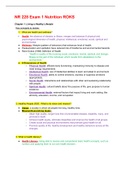Exam (elaborations)
NR 228 Exam 1 Nutrition ROKS
- Course
- Institution
NR 228 Exam 1 Nutrition ROKS Chapter 1: Living a Healthy Lifestyle Key concepts to review: 1. What are health and wellness? • Health: the absence of disease or illness, merges and balances 6 physical and psychological dimension of health, physical, intellectual, emotional, social, spiritual...
[Show more]



